Optimal Configuration of Hybrid Energy Storage Capacity in a Grid-Connected Microgrid Considering Laddering Carbon Trading and Demand Response
Abstract
:1. Introduction
2. System Composition and Control
2.1. System Structure and Mathematical Models
2.2. Energy Scheduling Strategy
2.3. Demand Response
3. Optimal Configuration Model
3.1. Objective Function
3.1.1. Economy Model
3.1.2. Reliability Model
3.2. Constraints
3.2.1. Power Balance Constraints
3.2.2. Storage Operational Constraints
3.2.3. System Operational Constraints
3.3. Optimization Method of the Configuration Model
4. Case Study
4.1. Different Scenario Setting and Result Analysis
4.1.1. Impact of Different Carbon-Trading Calculation Models on Capacity Configuration
4.1.2. Impact of Demand Response on Capacity Configuration
4.2. Analysis of Load Characteristics with Demand Response
4.3. Sensitivity Analysis of Demand Response
4.4. Sensitivity Analysis of Other Parameters
5. Conclusions and Discussion
- There is a contradiction between the economy and reliability of power supply in the microgrid, and they cannot be optimized at the same time. When the overall profit rises, the reliability of the power supply decreases; when the overall profit decreases, the reliability of the power supply increases.
- When the model for calculating the cost of carbon trading changes from conventional to laddering, the penalties for carbon trading increase, and the overall profit of the microgrid decreases. The increased cost of power purchases by microgrids from the grid leads to a decrease in the amount of purchased power, which favors new energy generation for the grid, resulting in an increase in the capacity configuration of PV and BAT, as well as a rise in the reliability of the supply.
- Demand response makes the peak-to-valley difference in daily loads smaller and reduces the supply–demand power differential, thereby reducing the pressure on renewable energy generation and energy storage systems to store energy. This means that demand response allows microgrids to achieve greater economic efficiency with less configured capacity but with lower supply reliability.
- Different load shares in demand response can affect capacity configuration and system operation results. As the share of shiftable loads increases, the PV configuration capacity decreases, but the BAT configuration capacity increases; as the share of the served or substituted loads increases, the configuration capacity of both PV and BAT decreases. Both the increase in the share of shiftable and the served or substituted loads can contribute to the economics of microgrids but can lead to a decrease in the reliability of the supply.
Author Contributions
Funding
Data Availability Statement
Conflicts of Interest
References
- Mu, C.; Zhang, Y.; Jia, H.; He, H. Energy-Storage-Based Intelligent Frequency Control of Microgrid with Stochastic Model Uncertainties. IEEE Trans. Smart Grid 2020, 11, 1748–1758. [Google Scholar] [CrossRef]
- Hatziargyriou, N.; Asano, H.; Iravani, R.; Marnay, C. Microgrid. IEEE Power Energy Mag. 2007, 5, 78–94. [Google Scholar] [CrossRef]
- Wang, H.; Wang, T.; Xie, X.; Ling, Z.; Gao, G.; Dong, X. Optimal Capacity Configuration of a Hybrid Energy Storage System for an Isolated Microgrid Using Quantum-Behaved Particle Swarm Optimization. Energies 2018, 11, 454. [Google Scholar] [CrossRef]
- Li, P.; Li, R.X.; Cao, Y.; Li, D.Y.; Xie, G. Multi-objective sizing optimization for island microgrids using a triangular aggregation model and the levy-harmony algorithm. IEEE Trans. Ind. Inform. 2018, 14, 3495–3505. [Google Scholar] [CrossRef]
- Rajkumar, R.K.; Ramachandaramurthy, V.K.; Yong, B.L.; Chia, D.B. Techno-economical optimization of hybrid pv/wind/battery system using Neuro-Fuzzy. Energy 2011, 36, 5148–5153. [Google Scholar] [CrossRef]
- Alzahrani, A.; Ramu, S.K.; Devarajan, G.; Vairavasundaram, I.; Vairavasundaram, S. A review on hydrogen-based hybrid microgrid system: Topologies for hydrogen energy storage, integration, and energy management with solar and wind energy. Energies 2022, 15, 7979. [Google Scholar] [CrossRef]
- Lu, Z.M.; Li, Y.T.; Zhuo, G.Y.; Xu, C.B. Configuration optimization of hydrogen-based multi-microgrid systems under electricity market trading and different hydrogen production strategies. Sustainability 2023, 15, 6753. [Google Scholar] [CrossRef]
- Lu, S.Y.; Lou, S.H.; Wu, Y.W.; Yin, X.G. Power system economic dispatch under low-carbon economy with carbon capture plants considered. IET Gener. Transm. Distrib. 2013, 7, 991–1001. [Google Scholar] [CrossRef]
- Fu, X.; Zeng, G.; Zhu, X.X.; Zhao, J.; Huang, B.; Liu, J. Optimal scheduling strategy of grid-connected microgrid with ladder-type carbon trading based on Stackelberg game. Front. Energy Res. 2023, 10, 961341. [Google Scholar] [CrossRef]
- Han, Y.; Yu, S.C.; Li, L.Y.; Hou, Y.J.; Li, Q.; Chen, W.R. Low-carbon and economic configuration method for solar hydrogen storage microgrid including stepped carbon trading. High Volt. Eng. 2022, 48, 2523–2533. [Google Scholar]
- Cui, Y.; Wang, Y.; Xu, Y.; Zhao, Y. Low-carbon economic dispatching of microgrid considering generalized integrated demand response and nonlinear conditions. Energy Rep. 2023, 9, 1606–1620. [Google Scholar] [CrossRef]
- Zhu, Y.; Hu, Z.; Yang, J.; Chang, Q.; Nie, C. Low carbon optimal dispatching of microgrid considering demand response. In Proceedings of the Asia Power and Electrical Technology Conference (APET), Shanghai, China, 11–13 November 2022; pp. 366–373. [Google Scholar]
- Li, H.; Lin, L. Optimal dispatch of CCHP microgrid considering carbon trading and integrated demand response. Distrib. Gener. Altern. Energy J. 2022, 3, 1681–1702. [Google Scholar] [CrossRef]
- Sugimura, M.; Gamil, M.M.; Akter, H.; Krishna, N.; Abdel-Akher, M.; Mandal, P.; Senjyu, T. Optimal sizing and operation for microgrid with renewable energy considering two types demand response. J. Renew. Sustain. Energy 2020, 12, 065901. [Google Scholar] [CrossRef]
- Long, Y.L.; Li, Y.; Wang, Y.H.; Cao, Y.J.; Jiang, L.; Zhou, Y.C.; Deng, Y.Y.; Nakanishi, Y. Low-carbon economic dispatch considering integrated demand response and multistep carbon trading for multi-energy microgrid. Sci. Rep. 2022, 12, 6218. [Google Scholar] [CrossRef]
- Theodorakatos, N.P.; Babu, R.; Moschoudis, A.P. The branch-and-bound algorithm in optimizing mathematical programming models to achieve power grid observability. Axioms 2023, 12, 1040. [Google Scholar] [CrossRef]
- Theodorakatos, N.P.; Lytras, M.D.; Moschoudis, A.P.; Kantoutsis, K.T. Implementation of optimization-based algorithms for maximum power system observability using synchronized measurements. AIP Conf. Proc. 2023, 2872, 120006. [Google Scholar]
- Luo, Z.; Yang, S.; Xie, N.; Xie, W.; Liu, J.; Souley Agbodjan, Y.; Liu, Z. Multi-objective capacity optimization of a distributed energy system considering economy, environment and energy. Energy Convers. Manag. 2019, 200, 112081. [Google Scholar] [CrossRef]
- Xu, C.; Ke, Y.; Li, Y.; Chu, H.; Wu, Y. Data-driven configuration optimization of an off-grid wind/PV/hydrogen system based on modified NSGA-II and CRITIC-TOPSIS. Energy Convers. Manag. 2020, 215, 112892. [Google Scholar] [CrossRef]
- Li, J.; Zhao, J.; Chen, Y.; Mao, L.; Qu, K.; Li, F. Optimal sizing for a wind-photovoltaic-hydrogen hybrid system considering levelized cost of storage and source-load interaction. Int. J. Hydrogen Energy 2023, 48, 4129–4142. [Google Scholar] [CrossRef]
- Mao, M.Q.; Jin, P.; Chang, L.C.; Xu, H.B. Economic analysis and optimal design on microgrids with SS-PVs for industries. IEEE Trans. Sustain. Energy 2014, 5, 1328–1336. [Google Scholar] [CrossRef]
- Jin, S.; Botterud, A.; Ryan, S.M. Impact of demand response on thermal generation investment with high wind penetration. IEEE Trans. Smart Grid 2013, 4, 2374–2383. [Google Scholar] [CrossRef]
- Chen, A.W.; Hua, H.R.; Li, P.; Su, Y.F. Optimal operation of AC/DC hybrid micro-grid based on real-time price mechanism. Power Syst. Prot. Control 2017, 45, 13–20. [Google Scholar]
- Stoft, S. Power System Economics: Designing Markets for Electricity; Wiley-IEEE Press: New York, NY, USA, 2002; pp. 140–152. [Google Scholar]
- Wang, Y.; Lin, Y.; Du, B.; Liu, Y.; Xu, S.; Li, D.; Wang, D. Operational optimization of an integrated electricity-thermal energy system considering demand response under a stepped carbon trading mechanism. J. Phys. Conf. Ser. 2022, 2396, 012056. [Google Scholar] [CrossRef]
- Borowy, B.; Salameh, Z. Methodology for optimally sizing the combination of a battery bank and PV array in a wind/PV hybrid system. IEEE Trans. Energy Conver. 1996, 11, 367–375. [Google Scholar] [CrossRef]
- Deb, K.; Pratab, A.; Agarwal, S.; Meyarivan, T. A fast and elitist multi-objective genetic algorithm: NSGA-II. IEEE Trans. Evolut. Comput. 2002, 6, 182–197. [Google Scholar] [CrossRef]
- Zuo, G.L.; Guo, H.X.; Lin, W.Z.; Yu, Y.L.; Lu, Y.H. Optimal configuration of microgrid considering low-carbon hydrogen production. Elect. Power Autom. Equip. 2023, 43, 9–18. [Google Scholar]
- Yang, D.F.; Jiang, C.; Cai, G.W.; Huang, N.T.; Liu, X.J.; Huang, Z. Multi-objective optimal configuration of ac/dc microgrid considering electricity/heat coupling. Autom. Electr. Power Syst. 2020, 44, 1000–1026. [Google Scholar]
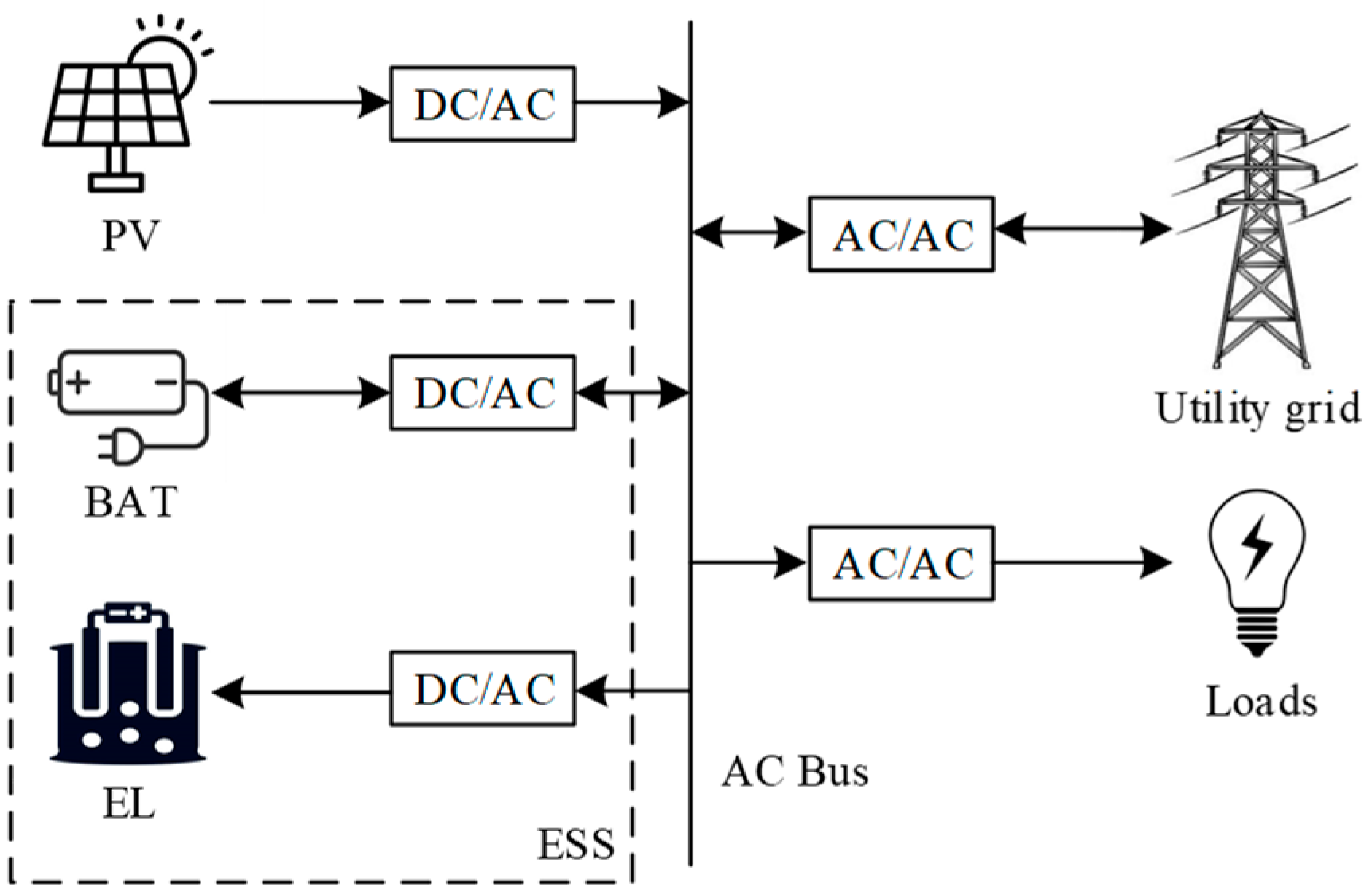


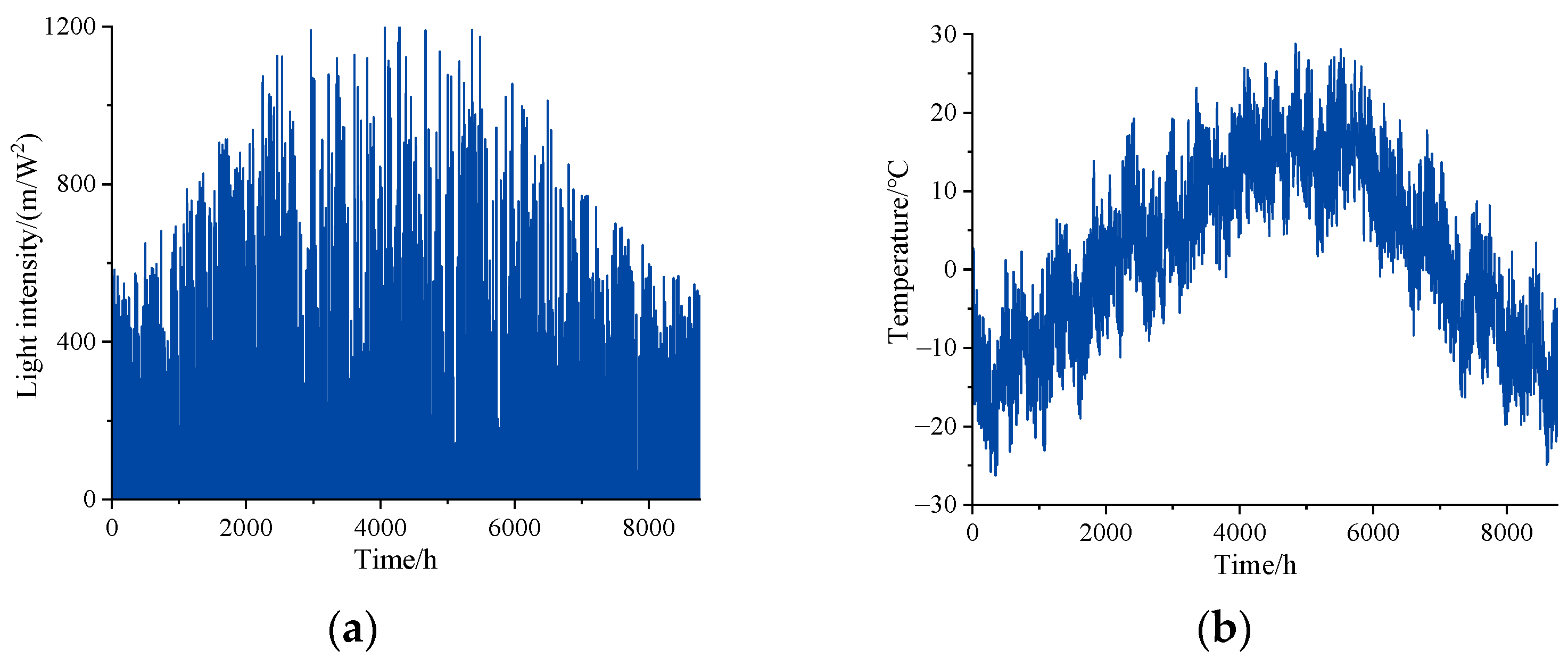
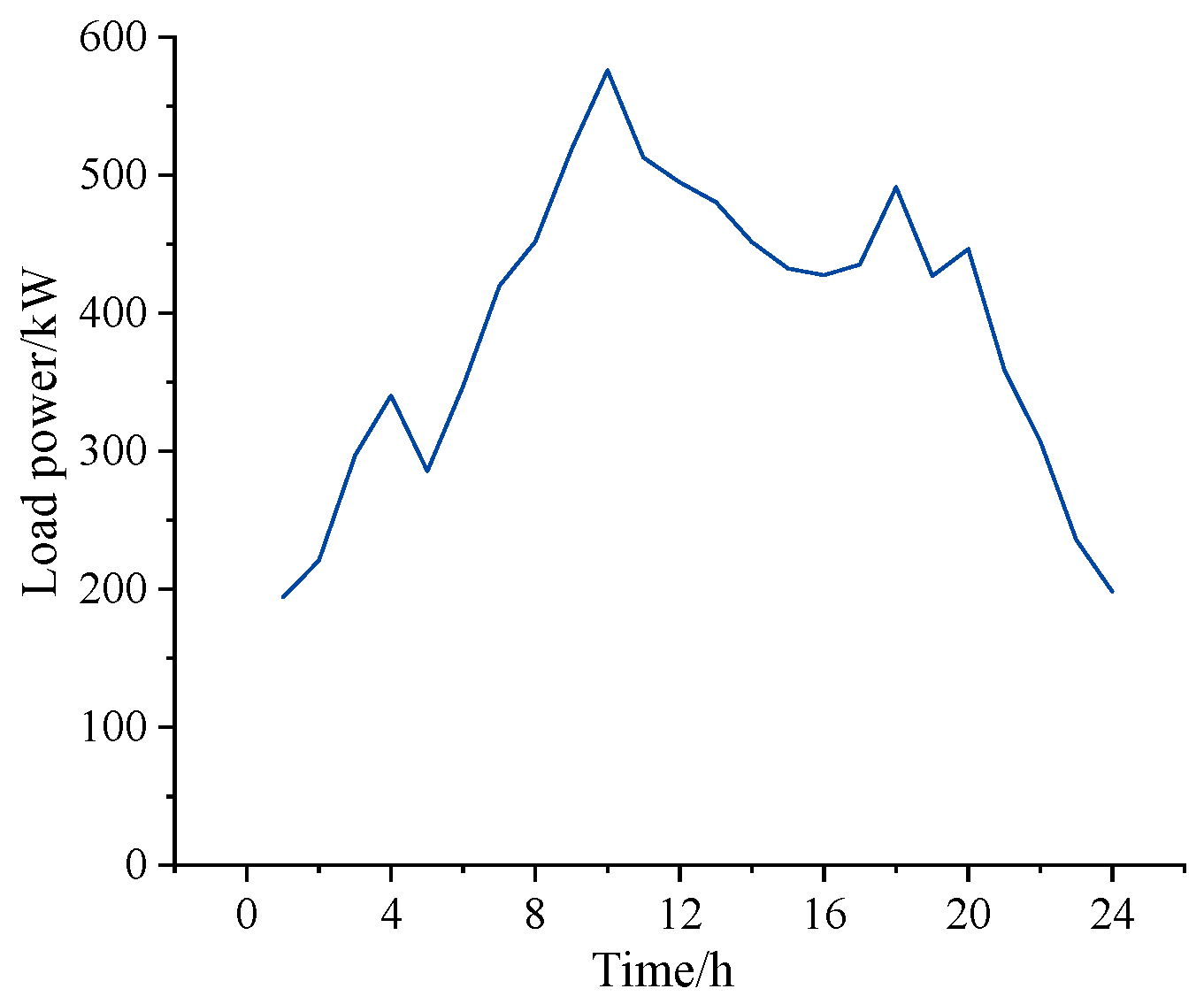


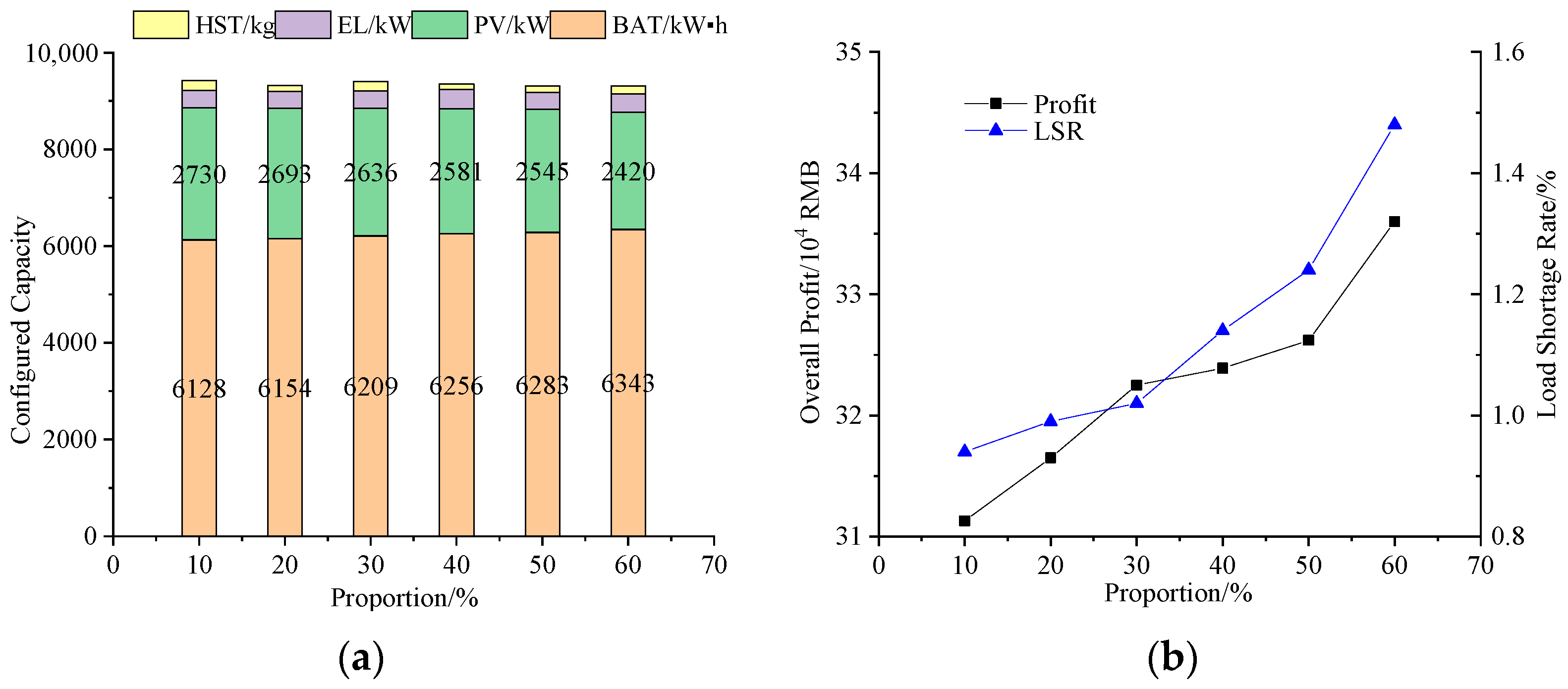
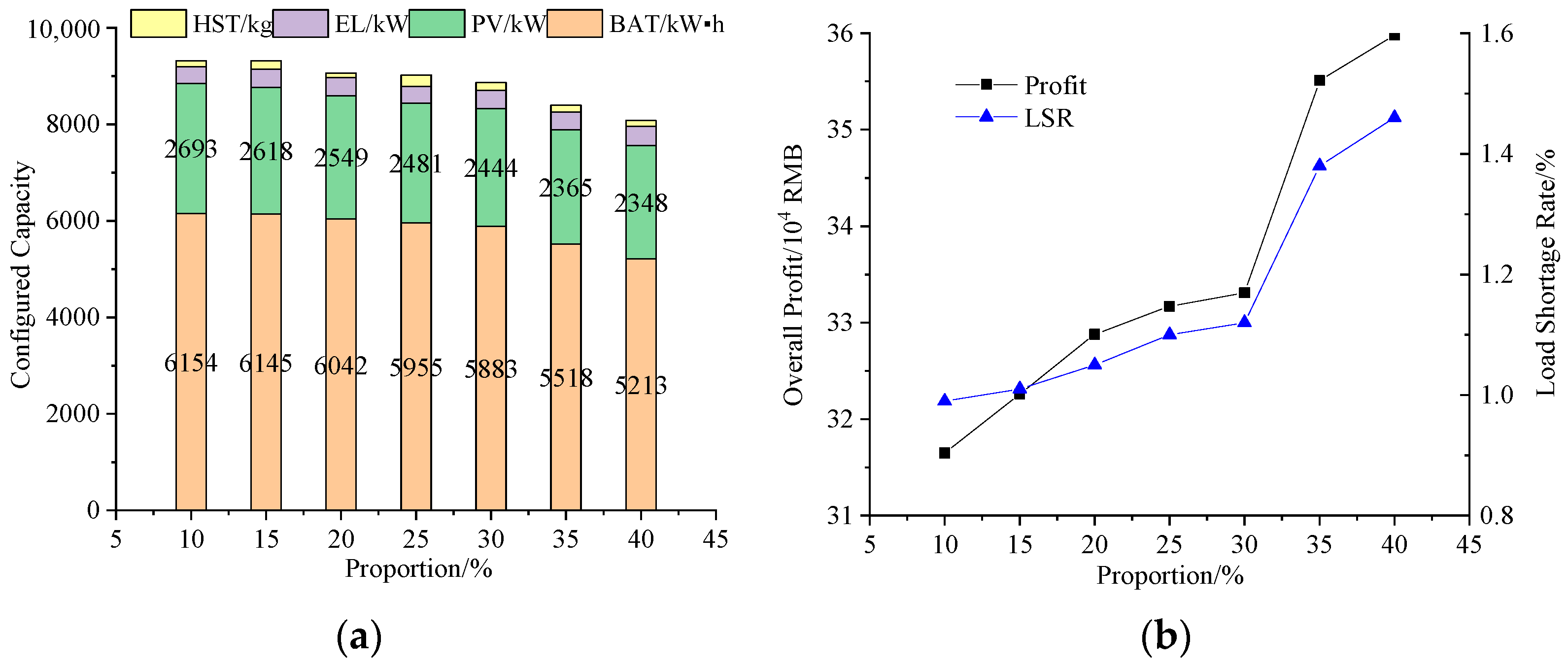
| Equipment | Investment Cost | O&M Cost | Lifespan/Year |
|---|---|---|---|
| PV | 6195 RMB/kW | 0.15 RMB/kW | 20 |
| BAT | 1070 RMB/kW h | 5 RMB/kW h | 10 |
| EL | 7615 RMB/kW | 120 RMB/kW | 10 |
| HST | 2600 RMB/kg | 19 RMB/kg | 20 |
| Time Period | Purchasing Price | Selling Price |
|---|---|---|
| 0:00–8:00 | 0.37 RMB/kW h | 0.28 RMB/kW h |
| 12:00–17:00, 21:00–24:00 | 0.69 RMB/kW h | 0.53 RMB/kW h |
| 8:00–12:00, 17:00–21:00 | 0.87 RMB/kW h | 0.72 RMB/kW h |
| Scenarios | PV/kW | BAT/kW h | EL/kW | HST/kg | Profit/104 RMB | LSR/% |
|---|---|---|---|---|---|---|
| I | 2762 | 6271 | 357 | 237 | 29.13 | 0.98 |
| II | 2810 | 6448 | 379 | 181 | 25.75 | 0.91 |
| III | 2693 | 6154 | 353 | 114 | 31.65 | 0.99 |
| IV | 2731 | 6382 | 357 | 153 | 27.88 | 0.92 |
| Scenarios | RE/104 RMB | RH2/104 RMB | CInv/104 RMB | CRun/104 RMB | CCO2/104 RMB | Load Shortage /104 kW h |
|---|---|---|---|---|---|---|
| I | 260.64 | 68.81 | 223.92 | 84.47 | 1.13 | 3.37 |
| II | 261.33 | 70.41 | 228.22 | 86.05 | 1.88 | 3.11 |
| III | 255.90 | 67.27 | 216.57 | 82.22 | 1.20 | 3.44 |
| IV | 256.39 | 68.58 | 221.65 | 83.51 | 1.97 | 3.19 |
| Parameter | Base Value | Changed to | Change in Profit (%) | Change in LSR (%) |
|---|---|---|---|---|
| Hydrogen price | 55 RMB/kg | 44 RMB/kg (−20%) | −18.80 | −5.17 |
| 66 RMB/kg (+20%) | 16.78 | 5.30 | ||
| Carbon trading price (regular) | 247.33 RMB/t | 197.86 RMB/t (−20%) | 12.02 | 6.69 |
| 296.80 RMB/t (+20%) | −15.23 | −7.43 | ||
| Growth rate of carbon trading prices | 25% | 20% (−20%) | 10.16 | 3.39 |
| 30% (+20%) | −9.82 | −4.18 |
Disclaimer/Publisher’s Note: The statements, opinions and data contained in all publications are solely those of the individual author(s) and contributor(s) and not of MDPI and/or the editor(s). MDPI and/or the editor(s) disclaim responsibility for any injury to people or property resulting from any ideas, methods, instructions or products referred to in the content. |
© 2023 by the authors. Licensee MDPI, Basel, Switzerland. This article is an open access article distributed under the terms and conditions of the Creative Commons Attribution (CC BY) license (https://creativecommons.org/licenses/by/4.0/).
Share and Cite
Xu, Z.; Chen, F.; Yang, X.; Lu, Q. Optimal Configuration of Hybrid Energy Storage Capacity in a Grid-Connected Microgrid Considering Laddering Carbon Trading and Demand Response. Energies 2024, 17, 139. https://doi.org/10.3390/en17010139
Xu Z, Chen F, Yang X, Lu Q. Optimal Configuration of Hybrid Energy Storage Capacity in a Grid-Connected Microgrid Considering Laddering Carbon Trading and Demand Response. Energies. 2024; 17(1):139. https://doi.org/10.3390/en17010139
Chicago/Turabian StyleXu, Zhanpeng, Fuxin Chen, Xuefan Yang, and Qinfen Lu. 2024. "Optimal Configuration of Hybrid Energy Storage Capacity in a Grid-Connected Microgrid Considering Laddering Carbon Trading and Demand Response" Energies 17, no. 1: 139. https://doi.org/10.3390/en17010139
APA StyleXu, Z., Chen, F., Yang, X., & Lu, Q. (2024). Optimal Configuration of Hybrid Energy Storage Capacity in a Grid-Connected Microgrid Considering Laddering Carbon Trading and Demand Response. Energies, 17(1), 139. https://doi.org/10.3390/en17010139







